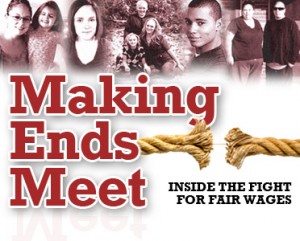 Singles Moms, Children, the Elderly and Students Have Much at Stake in the Living Wage Debate
Singles Moms, Children, the Elderly and Students Have Much at Stake in the Living Wage Debate
Opponents of raising the minimum wage frequently argue that low-wage jobs are transitional, for teenagers seeking experience before life in the “real world.” Granted, many teenagers work to contribute money desperately needed for their family, or are raising families themselves. And many teens are trying to save up for college.
But, like young people, these facts apparently don’t seem to matter to profit-at-all-costs corporations. Nor do actual statistics of minimum wage workers and people in poverty.
The truth is that four of five people struggle with joblessness, are near poverty, or rely on the safety net at some point in their lives. Of all minimum-wage workers in the U.S. who would benefit from an increase in wages, 88 percent are over age 20. The median age of workers is 35, and more than 35 percent are over the age of 40. So, yes, raising the minimum wage will affect teenagers. But it will also affect many others.
Single Moms
Even in 2013, women make 77 cents for every dollar their male counterparts earn. In other words, they make less money while doing the exact same job. Women with children also face losing an additional 6-8 percent in average wages if they have a child. Women also face significant barriers in promotions and discrimination in hiring. So what does this mean?
The majority of workers making minimum wage are women. And of fast food workers alone, 15 percent of workers are single moms, 100 percent of whom barely make ends meet for themselves, let alone being able to afford child care for their children. But just 7 percent received any form of childcare assistance, which costs, on average, almost $1,000 a month. Where again was that in McDonald’s suggested budget
And if these children eventually want to get a job that actually helps buy food or allows them to save up for school? Eh, it’s OK. They’re just teenagers. It’s better to keep the vicious cycle of poverty up and running because low-wage workers are just too profitable.
Children
Low wages don’t just impact workers — almost half of children under 18 live in a low-income home, and more than 17 million have parents who would benefit from a minimum-wage increase.
The Elderly
Like all of us, seniors have bills to pay. Social Security, Medicare and Medicaid have helped make many of these bills more manageable. However, cuts to these programs only grow greater, while costs continue to increase. Fewer seniors are covered by defined benefit plans, and many have seen their retirement investments crumble with the stock market. Mortgages, loans, medical bills, and other living expenses now weigh on seniors so heavily that many are forced out of retirement.
The rate of retirees forced to return to the labor force has doubled in the past decade. Not only is this predicament unfortunate to begin with, but many are forced to take minimum-wage jobs because of a weak job market. (In fact, many economists say this is why teen unemployment has increased.)
We have long recognized the need for public assistance programs for our elderly, and many restaurants, movie theaters and retail stores offer discounts for those 65 and older. Yet, when many realize that they are unable to make ends meet, they do not have the opportunity to do so on their own.
Students
We often neglect an entire population that frequently lives in poverty: college students. In fact, about 52 percent of students live in poverty, compared to 15 percent for the general population. Yet, students are excluded from many public assistance programs, especially if they are unable to go to school full-time and also work 20 hours a week.
The “starving students” caricature is real, and it does not end at graduation. Seventy percent more college graduates are entering minimum-wage jobs than was the case 10 years ago. And, if they’re lucky enough to score a job that requires a bachelor’s degree (only half of them are), their median wage is still less than it was a decade ago.
Student loans are being defaulted and deferred at record rates, and it’s no wonder why. Student debt has surpassed $1 trillion, and is the second greatest form of household debt. Teenagers are unable to save for school, and 20-somethings are unable to make any form of dent in their debt — which, regardless of bankruptcy, won’t be forgiven.
Who are working these minimum-wage jobs? A wide variety of folks. Some are saving up for their education. Some are trying to raise a family. Some are starting over after losing a job, or going through a divorce. But when the majority of jobs being created are low-wage positions, something has to change. People should not make less than workers did in the ’60s working the same jobs.